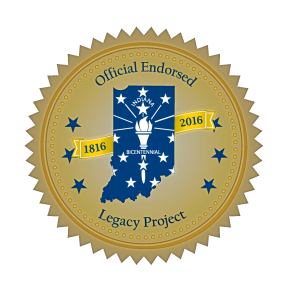IF THE RIVER COULD TALK
RIVER FORDS
Getting Across the White River Not Always Easy
The use of the bridge at County Road 600 West was welcomed by many residents in the area. The bridge was much safer than fording the White River.
Today, Lone Oak Road(County Road 500 West) stops at its intersection with West Eighth Street Road. The ford is north and a little west of this intersection.
In 1876, Mr. J. Epperly owned property on both sides of White River where the ford was located, undoubtedly giving the ford its name. Indian Creek flows into White River from the north near the ford. On the south side of the river, opposite the creek's egress, there was a cluster of businesses nestled into a hollow that included a sawmill and blacksmith shop.
If the river could talk, it would tell of a threshing rig that unexpectedly crossed the river at the Epperly Ford in 1915. The rig was located in a farm field next tho the hollow. Having completed its work, it was necessary to move the rig to fields that were on the opposite side of the river. To get to the other side, meant driving the rig to Hamilton by way of the Eighth Street Road, turning north on County Road 600 West, crossing the river on the bridge, and then going back around on the north side to the fields. Another option was to use the nearby Epperly Ford. Adding to the problem this time was the disappearance of the rig's operator. The solution was nearby.
A young boy by the name of Chet Kreegar was driving a team of horses hitched to a wagon picking up sheaves of wheat. The farmers knew of young Kreegar's mechanical instincts and asked if he could drive the rig over the land route to the next field. Obviously up to the task, he fired up the big rig and in a surprising move, ran it down to the ford, splashed through and up the other side. He then yelled back across the river asking where they wanted the rig set down.
Tragedy Strikes
If the river could talk, it would reveal that a short distance west, perhaps no more than a quarter-mile downriver, was Jackson Township's second ford, the Robinette Ford, the 10th in the series. Most likely it derived its name from a farm owned by L. & A. Robinette on the river's north side. If County Road 550 West crossed White River, the Robinette Ford would be the site.
West of present-day Hamilton were the third and fourth fords in the township. The third was known as the McClintick-Coy Ford, and it was approximately one mile west of Hamilton. At the ford, Mr. A. McClintick owned property on the river's north side, while Mr. M. Coy owned property on the south side. If County Road 700 West crossed the river, the ford would be the side.
ded people traveling west to the Moss Island Mill a viable option as opposed to continuing west on the turnpike where it intersected with a road (Baxter Road) that led to the Moss Island Ford, the seventh ford in the series. It had the reputation of being a bad ford, even when the water level was low. When the water level was high, a canoe was kept there to ferry people across.
On Friday, July 19, 1889, a group of boys of various ages were enjoying a swim in White River at the McClintick-Coy Ford. If the river could talk, it would tell of a tragedy over a couple of days.
The river was somewhat swollen due to recent rains and the older boys would not let the younger ones in the water for fear something terrible might happen. Not heeding the warning, two younger boys went farther down the river, removed their clothing and waded in. One was 12-year-old Philip Hosier, and the other was a 9-year-old whose last name was Todd. Soon they encountered a swift current that carried them into water over their heads, and before the older boys could help them, they drowned.
Area residents combed the shores in hope of finding the bodies, but to no avail. The search was continued on Saturday, but with no results. On Sunday morning, hundreds of people resumed the search. The bodies were finally found on the opposite side well below where they had entered the river.
A farmer, Stephen Bilby, Who had worked tirelessly that Sunday searching for the boys, also lost his life. He had been in the water since early morning, and near noon, when 20 to 30 feet from the shore, he lost his grip of a rope that had been stretched across the river and was swept away in the swift current. He was pulled under and drowned. His body was recovered later that day two miles downriver.
The last crossing, although not a ford, was at Perkinsville just before White River exits Madison County.
Without a doubt, there were probably more fords and crossings of White River in Madison County, but knowledge of their whereabouts has been lost over time. If only the river could talk!
Stephen T. Jackson, Madison County Historian

Throughout Indiana's Bicentennial year of 2016, Steve Jackson, Madison County Historian, will be authoring "If The River Could Talk." This series will feature people, places, and events that takes place in and around White River.
The series is an officially endorsed legacy project of the Indiana Bicentennial Commission.
Madison County Historical Society|15 West 11th Street, P. O. Box 696, Anderson, Indiana 46015-0696|(765)683-0052|madisonchs10@gmail.com